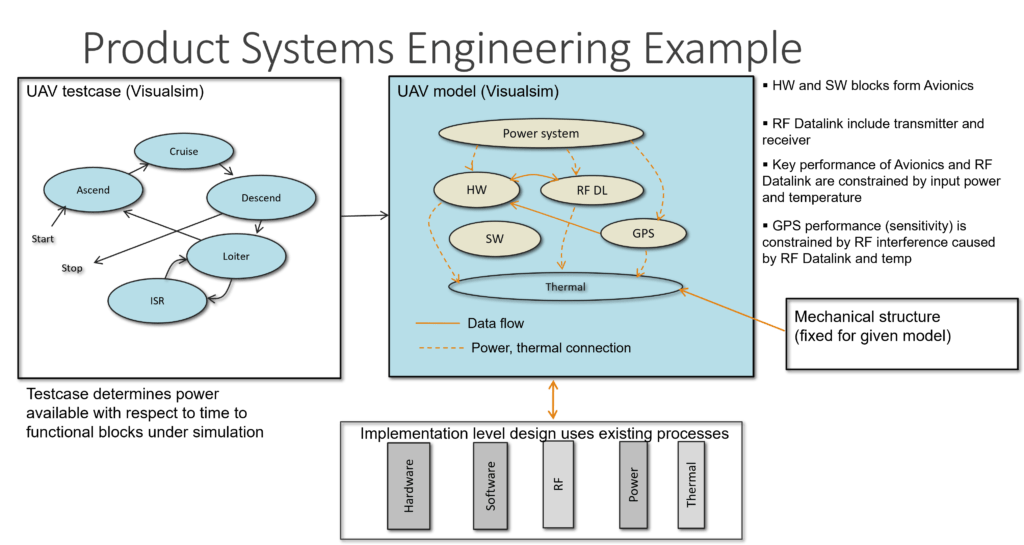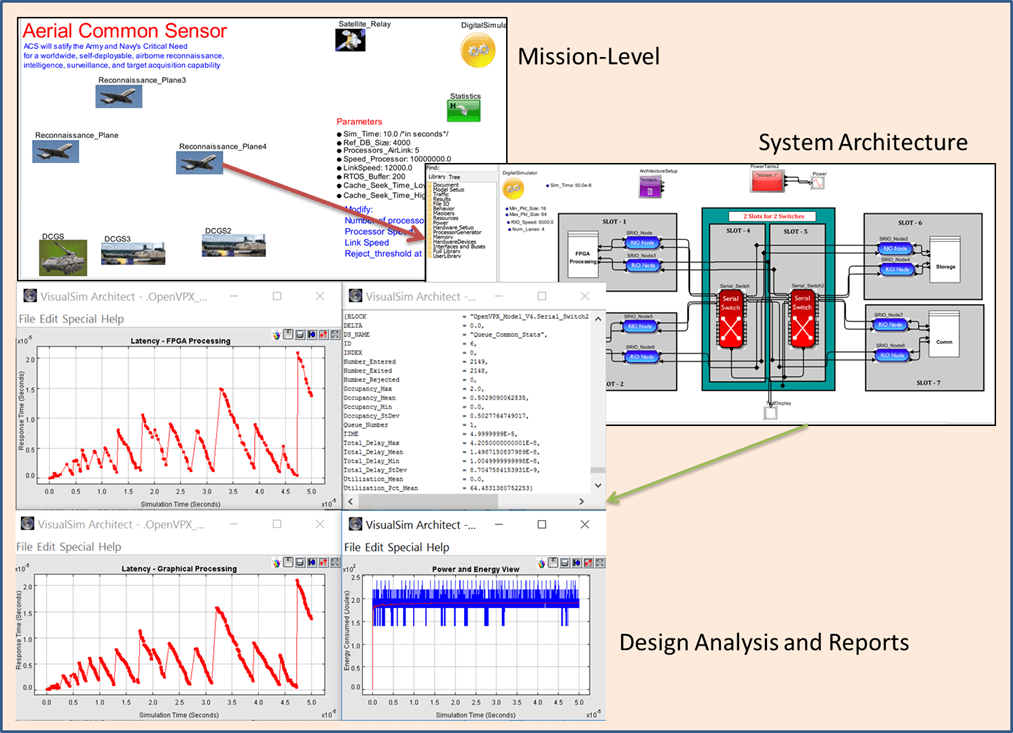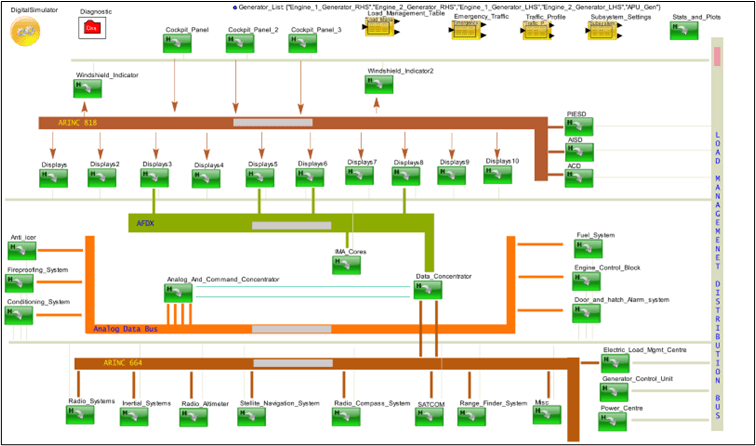Overview
Mirabilis Design is the eco-system for cyber-physical system design with an integrated communication, test, and exploration from requirements to deployment. VisualSim Architect brings together all engineering disciplines in a single multi-simulator environment to assign software tasks to compute resources, optimize the compute resource, design the network topology of boards, and connect with other simulators and spreadsheets. The cyber-physical model can be tested for efficiency, functionality, reliability and safety, of cyber-physical systems.
The company is based in Santa Clara, CA, and has a large customer base in aerospace, defense, automotive and semiconductors. Mirabilis Design provides multiple models of computation simulation platform, system-level modeling IP, Open API for simulators, physical systems integration using behavior or spreadsheet, software, AI-based analytics, and collaboration framework. The System-level modeling IP covers semiconductor internals, electronics, physical models, communication systems, software, network, avionics, navigation systems, radars, and displays. To measure the quality and efficiency of the system, the cyber-physical models are tested for performance, power, functionality, software correctness, cybersecurity intrusions and failure of the electronics, software, semiconductor and network.
The System Design Eco-System supports requirements validation, collaborative engineering, architecture exploration, uniform communication, integration test and field debugging. VisualSim Architect is a library-based graphical modeling and simulation environment for electronic systems, semiconductor devices, networks, and software. Using VisualSim, architect, test and integration engineers can quickly construct models using the IP blocks, import SysML definitions of the behavior, map the behavior against the architecture, run parameters sweeps, monitor against requirements, generate executable specification, and provide reference models for mission design. Reports generated by VisualSim Architect include latency, signal strength, throughput, power consumption, heat generated, functional correctness, scheduling, quality-of-service, safety, reliability, mean-time to detection, mean-time to respond, intrusion success rate, and metrics.
What we are looking from a Partner
Cyber physical resilience testing requires running large number of use-cases, transition the entire system specification to discrete-event for abstraction, parameterize to enable ease-of-adoption, generate a variety of known and unknown faults, and automate the adoption of data on electronics, software, network and physical systems. These cyber-physical models must communicate with the entire implementation development flow to feed integration data upwards, while providing requirements, specification, test traces and constraints downwards.
The cyber-physical model is the reference and communication framework, that allows for collaboration between the teams and the different tools in the design chain. The system model integrates all aspects of the system definition and provides a flow from the conceptual to implementation.
Implementation tools in the design flow include algorithmic, RTL, schematics, thermal systems, analog and RF, antenna, MEMS and connectors, electrical power generators, power storage and Mechanical systems. It is important to track and maintain the communication between the sub-systems, teams, partners, and the downstream software tools.
Traditional methods of testing depend on emulation, prototypes, and complex interfaces. Some of these require complex integration of multi-domain complex simulation at an extremely detailed level. These tend to be very late in the design process, extremely slow to make work, takes a long time to simulate, and any changes made at this stage are not updated in the specification and requirements.
System-level Cyber-Physical models can abstract the information in the implementation and continuous time simulation and change the paradigm that enables software compute to be introduced into the equation. This way cyber-physical resilience can incorporate both the physical and the abstracted software application to create a set of metrics to measure the success of the resolution against the vulnerabilities.
Partners for the cyber-physical engagement will be in the form of integration teams that have the design awareness and the detailed implementation teams that have the simulation attribute knowledge. The partnership would lead to a continuous evaluation loop that will incorporate changes anywhere in the design process back into the cyber-physical system model.
Key Benefits
-Fast modeling (3 weeks for a full avionics system) and simulation speed (10 Mhz)
-Largest library of modeling IP that covers over 250 applications
-Well-proven methodology with over 80 customers and 175 products developed
-High model accuracy from 94-98%
-Single platform for semiconductors, systems, and networks
-Scalable for new criteria and vulnerabilities, without programming
Key features
-Stochastic, hybrid and cycle-accurate modeling library
-Mixed model of computation integrates digital, analog, DSP, controls, network, and software
-Complete library of standards, technology, and application (over 600)
-Rapid generator for processors, memories, buses, IPs, networks and RTOS
-AI-based diagnostic and bottleneck detection system
-Graphical modeling, analysis and debugging
-Open API to integrate with simulators, hardware, instruments, traces, and software
-Analysis covers performance, functionality, power, vulnerability testing and integration issues
-Traffic generation for sensors, distribution, task sequence, and traces
Applications
Application Areas
-Mission of missiles, aircrafts, ground stations, moving vehicles, and satellites
-Full spacecraft, launcher, aircraft and vehicles
Systems of processor, GPU, memory, SSD, bus, interfaces, OS, networks and software
-Semiconductor internals of SoC, switches, controllers and processors
-Real-time software and firmware connected to mechanical and MEMS devices | Explorations
Select the right architecture and components for the target use-cases.
Trade-off implementation based on power, latency, and functionality.
Eliminate risks, predict bottlenecks, and respond to vulnerabilities.
Collaborative design across corporations
Experiment with new technology and integrate custom resources |
Capabilities
-Specialist in system-level simulation, modeling, and analysis
-Understand modeling abstraction to speed up model construction
-Build IP components are parameterized to create new variations easily
-Integrating technologies into a single model- analog, digital, software, control and physical
-Using AI to Interpret results and detect anomalies
Case Studies
Product-level Use Case

The UAV is a cyber-physical system that is built up using multiple sub-systems. These sub-systems are procured from multiple vendors and include the chassis, compute boards, sensors, power systems, antennas, gyros, GPS, navigation, and communication systems. A detailed exploration must be performed prior to selection of the components. The current mechanism of UML documentation and spreadsheet analysis becomes highly inaccurate with complex scheduling, concurrent events and parallel processing. The selection of the components will have a huge impact of the battery requirements, charging times, cool system, allowable weight and spread of applications.
VisualSim is used to construct the physical model of the UAV and the use-case are assembled in the state machine editor. The model is used to measure the signal strength requirements, size the sub-systems components, measure the response times, design the power management, test for failure conditions and compliance testing. This model was constructed within a week and provided over 80% accuracy for the entire system.
The model provided a platform to quickly run use cases, possible error conditions and the compute required for future applications.
Mission-Level Use-Case

Integrated Electronics Systems Use-Case
